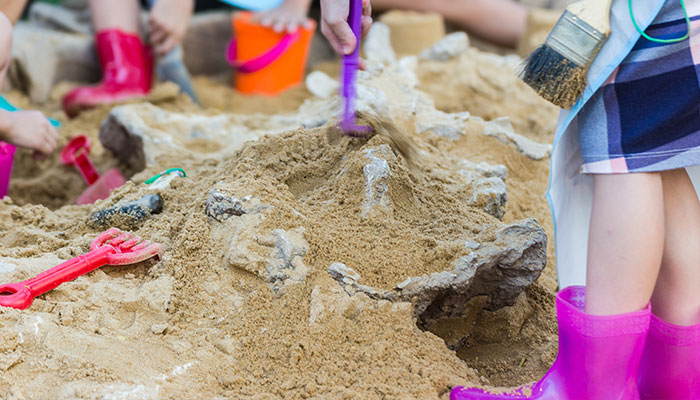While we believe that the books and resources recommended may be of value to you, keep in mind that these are suggestions only and you must do your own due diligence to determine whether the materials are appropriate and suitable for your use. PNC has no sponsorship or endorsement agreement with the authors or publishers of the materials listed.
COMMUNITY HELPERS

Dig It!
Children will learn about what paleontologists do and the tools that they use.

Lesson Objective
Children will explore what paleontologists do and experiment with the tools they use to learn about the history of life on Earth.
Science
What You'll Need
- Magnifying glasses – 1 for every 2 children
- Sieves or colanders – 4
- Small wooden mallets – 1 for every 2 children
- Used coffee grounds – 2 cups
- Flour – 2 cups
- Salt – 1 cup
- Sand – 3/4 cup
- Water – 1 cup
- Small plastic dinosaurs – 1 per child
- Measuring cup
- Paint brushes – 1 per child
- Plastic spoons – 1 per child
- Large bowl
- Newspaper – to cover tables
What To Do
Note: This activity involves creating an egg out of clay that will take up to a week to dry. The children will then use tools, similar to what a paleontologist uses, to open the eggs.
- Discuss information about paleontologists with the children (see "Did You Know?").
- Have the class measure each of the dry ingredients (flour, coffee grounds, sand, and salt) and place them in the large bowl.
- Let the children take turns mixing the ingredients with their hands.
- Measure the water.
- Gradually add the water to the bowl, stirring with hands until the mixture holds together.
- Give each of the children a clump of the dough mixture (approximately ¼ cup) and have them form it into the shape of an egg with one of the plastic dinosaurs in the middle.
- Allow up to a week for the eggs to air dry.
- Once dry, spread out newspaper on several tables. Seat a small group of children at each table and provide them with the tools you collected (paint brushes, sieves, spoons, wooden mallets, etc.).
- Encourage the children to use the variety of tools to gently open their fossilized eggs and examine what is inside.
- Explain how carefully and slowly paleontologists work. They are slow and careful so they do not damage any of the fragile items they find in the dirt or sand.
Resources
Home School Resources
Home educators: use these printable lesson PDFs to teach this lesson to your home schoolers. They're available in English and Spanish.
Content Provided By
Common Core State Standards Initiative – These lessons are aligned with the Common Core State Standards ("CCSS"). The CCSS provide a consistent, clear understanding of the concepts and skills children are expected to learn and guide teachers to provide their students with opportunities to gain these important skills and foundational knowledge [1]. Visit the CCSS


